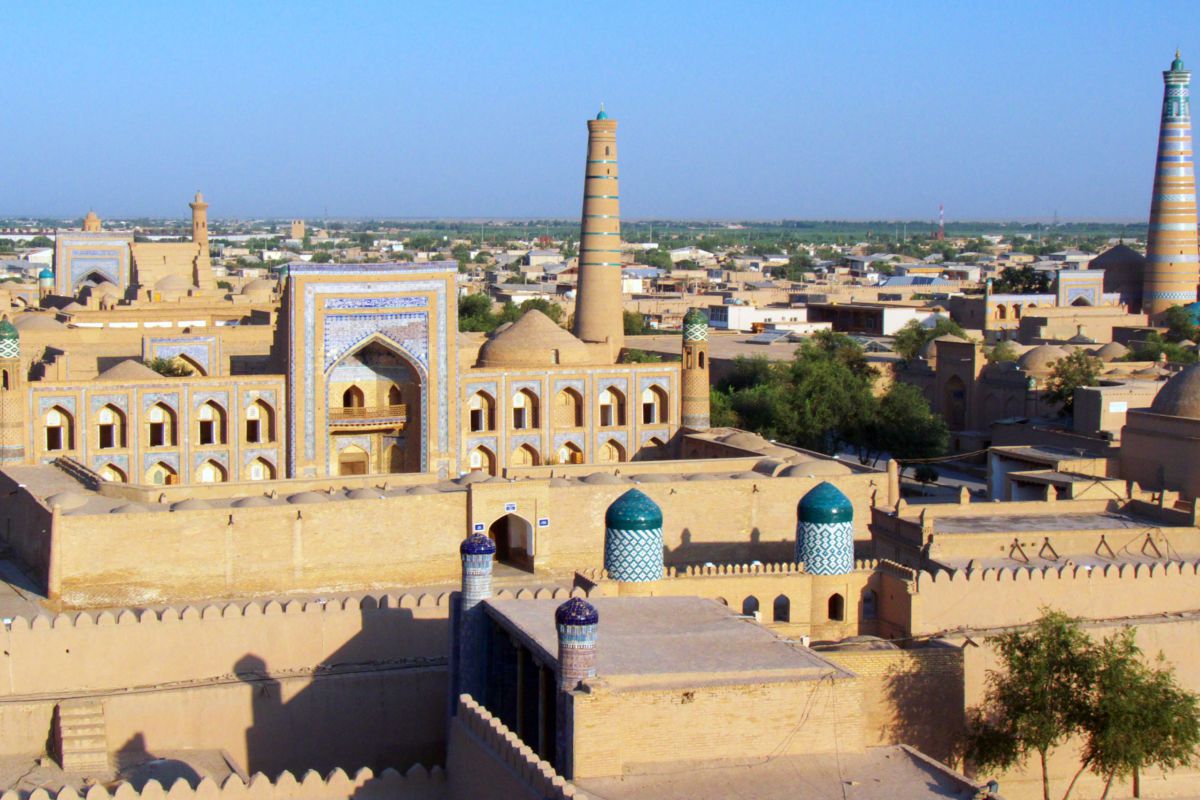Khiva

"At first sight, Khiva had a shabby, provincial and slightly disappointing feel to it. It was only as we turned the corner at the bottom of the road that the Ichan Kala loomed in front of us. The bulging mud-brick walls wound around a crowded centre of madrassahs, mosques, minarets and mausoleums like a large bronze snake basking in the autumn sun. Nearing the walls, we could see their crenellations and the impressive watchtower, giving the appearance of an elaborate sandcastle. Four enormous, turreted gates led into the inner city from the four points of the compass. We approached the Grandfather Gate and Jeanette introduced us to a plump woman who sold entry tickets. We would pay admission this time but, seeing as we were living in Khiva, wouldn't pay again. This was, after all, one of the main thoroughfares for getting to the bazaar."
"'It's a dry heat, a dry heat.' I kept repeating this mantra, but as the thermometer crept above 40°C and continued, I accepted that dry or humid, the weather was unbearably hot. We had no air-conditioning in the office so I would douse my T-shirt in water and put it on wet, the table-fan by the computer on full blast. The walled city was even worse - the huge mud-brick walls retaining the heat - and my bedroom was impossible to sleep in. I dragged my mattress up to the roof, joining the boys under the stars and enjoying the occasional night breeze. Getting up early felt unnatural but this was the only time when I had any energy. The summer days were long and the sun set around eight at night. I would return from the office, the slanted rays turning the Ichan Kala walls bronze. Girls spattered water from buckets around their house to settle the dust and take the edge off the heat. Grannies sat in the shade of a tree gossiping, and as the evening wore on, families dragged their televisions outside ready for the evening meal."
History
Khoresm was the scene of many battles and skirmishes for Alexander the Great, and the Arabian army. Under the command of Kuteyb ibn-Muslim, his army attacked Gurgandzh (the former capital of Khoresm) in 680, but could not permanently subduo the state for any length of time. After some centuries, Genghis Khan's united army managed to rush into the capital of the powerful state of Khoresmshah-Anushtegenids - Gurgandzh after a year long siege, having destroyed the dams on the Amu Darya River. A consequence of which was that the water of this turbulent river rushed into the city and practically wiped it from the face of the earth. However, the capital of Khoresm revived 200 years later.
Between the IX and XII centuries, a number of Muslim educational institutions, and large centres of science functioned successfully in Khoresm: schools of astronomy, mathematics, medicine and chemistry. The most well known was the Mamun Academy of Khoresm, which recently celebrated its 1000th anniversary; joined by the world community under the aegis of UNESCO. Muhammad-al-Khoresmi's fundamental works in mathematics, geography, and geodesy were already known in Europe by the IX century, and have not lost their importance to the present day. Al-Biruni, Agakhi, Nadzhmiddin Kubro and other scientists and seminary students, whose names are also connected with Khoresm, have left a rich, scientific and cultural heritage.
Amir Timur pursued five campaigns in Khoresm in the XIV century, but only in 1388 did he manage to win it completely. In due course, Khoresm blossomed again, and for a short period became one of the most important spiritual centres of the Muslim world. After Khiva's khanate was formed at the beginning of the XVI century, Khiva became its capital in 1598.
A major aspect of modern Khiva is characterised by the architecture of the Khivan khanate from the end the XVII century until the beginning of the XX century. However, archaeological excavations recently conducted here, show that in the basis of some rather "young" buildings rests ancient layers connected to the III and earlier centuries BC.
The historic heart of Khiva has been so well preserved that it’s often criticised as lifeless – a ‘museum city’. Even if you subscribe to that theory, you’ll have to admit that it’s one helluva museum. To walk through the walls and catch that first glimpse of the fabled Ichon-Qala (inner walled city) in all its monotoned, mud-walled glory is like stepping into another era. History is just a sniff away here.
The architectural monuments of Khiva are of unique value to the world. In the list of values of universal importance, Khoresm occupies a special place, as one of the centres of world civilisation and an important centre on the Great Silk Road. The city of Khiva was one of the first in Central Asia to be added to the UNESCO list as a place pertaining to the world heritage of mankind in 1990. Khiva celebrated its 2500th anniversary under the aegis of UNESCO in 1997.
You can see it all in a day trip from Urgench, but you’ll take it in better by staying longer. Khiva is at its best at dawn and by night, when the moonlit silhouettes of the tilting columns and medressas, viewed from twisting alleyways, work their magic.
Orientation
There’s not much reason to stray too far from the compact and user-friendly Ichon-Qala. Most sights are around its main axis, Pahlavon Mahmud, running between the West and East Gates. Walking through Ichon-Qala’s North Gate brings you into the new town, where banking and postal facilities are located.
